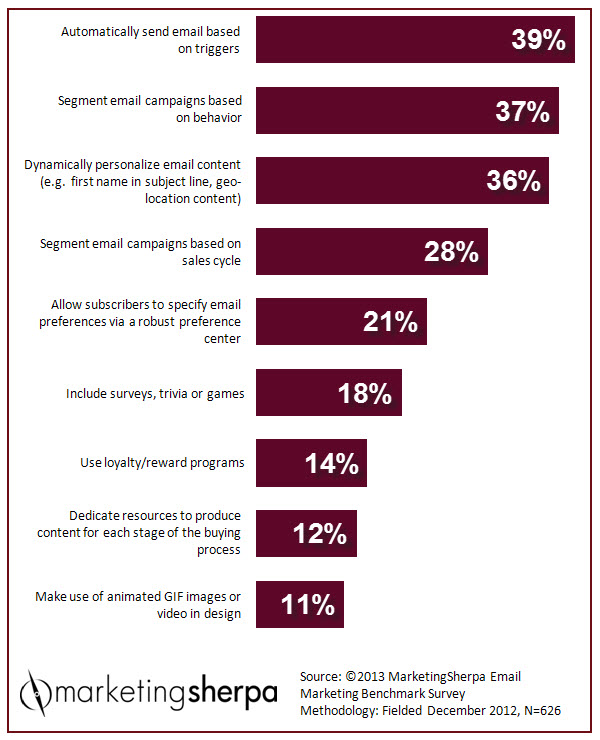Originally published on B2B LeadBlog
Marketing automation technology has become an indispensable tool in the complex sale marketer’s arsenal. Lead generation, lead nurturing and determining the time for the handoff to Sales would be extremely difficult without that technology. Add lead scoring and tracking through that final conversion to sale and the task is flat out impossible without automation.
Luckily, for B2B marketers there is a wide range of marketing automation options out there from relatively simple solutions that help streamline email marketing to full-blown packages that seem like they do everything but automate the lights and thermostat at the office.
To help illustrate how some of your peers are utilizing marketing automation, in this B2B Lead Roundtable Blog post, I’m sharing four MarketingSherpa case studies that cover everything from how automation improved lead gen to how that tech directly impacted the bottom line.
Case Study #1 — Marketing Automation: 200% increase in lead volume for software company after implementation
SmartBear Software, a B2B cloud mobile software company, was rapidly growing and decided to implement CRM software and marketing automation software as a single process to ensure the two technology pieces would be easily integrated.
When choosing the automation vendor, Keith Lincoln, Vice President of Marketing, SmartBear, said three main criteria were considered:
- Ease of use
- Scalability
- Integration with the new CRM system
Once an automation vendor was chosen, the team decided to bring in an outside consultant to expedite the implementation. Keith said this consultant helped speed up the learning curve through training and was able to get the automation solution up and running within a five-day workweek.
Automation in place, the team started slow with a few email campaigns, faced some internal challenges, but then quickly began to implement lead nurturing to handle a high volume of leads in different product groups. Lincoln said the automation solution was even integrated with SmartBear’s webinar platform.
Results? Lead volume grew 200%, 80% of global leads were generated with automated trial downloads, and 85% of SmartBear’s revenue was generated by the trial download leads.
Case Study #2 — Lead Generation: Revamped marketing automation and CRM technology drives 75% more leads
In this case study, Managed Maintenance Inc. (MMI), a provider of management services for technology assets, faced a different problem than SmartBear from the case study above.
Where SmartBear implemented automation and a CRM solution together to ensure those pieces were integrated, MMI had marketing automation and a CRM in place, but the two were siloed and weren’t synched — Marketing’s and Sales’ activities and data were completely separate.
The solution was to audit the current technology setup, and it was determined that MMI needed to replace both the automation and CRM tools together and, similar to SmartBear, implement the new software pieces together to ensure they would be integrated.
Once that occurred, Marketing at MMI was able to begin lead scoring and lead nurturing, and maybe even more importantly in terms of company culture, Sales and Marketing became more aligned because the new technology implementation allowed visibility from lead gen to conversion to sale for everyone involved in the whole pipeline.
After completely revamping marketing automation and CRM technology at MMI, lead generation was up 75% over the previous year.
Case Study #3 — Marketing Automation: Implementation drives $550,000 in net new revenue at Crain’s
Crain’s Business Insurance is a trade publication that faced the challenge all publications are undergoing right now with declining advertising revenue, but at the same time, its industry customers began buying up-front research and content.
Because the company has reporters with more than 300 years of combined writing and editorial experience, it was positioned to take advantage of this opportunity.
In order to do so, Crain’s implemented marketing automation, revamped and integrated its databases. The company had three databases: print subscribers, online registrants and the newly created marketing automation database — and integrated its content creation process into the marketing automation system.
Integrating content creation into the automation solution meant creating content categories and segmenting the database into those different groups to align content creation with certain reader segments.
From there, Crain’s implemented lead scoring, and even utilized analytics coming from marketing automation to influence the ongoing marketing strategy.
This campaign led to:
- Nearly $550,000 in brand-new advertising revenue for demand generation services
- A 43% increase in registered online newsletter subscribers
- A 2% increase in paid print subscribers
- Conversion rate of 2.6% from anonymous website visitors
Case Study #4 — Marketing Automation: IT company boosts leads 59%, generates $1.5 million with system implementation
This case study combines a dramatic lift in lead gen along with an impressive impact on the bottom line after CentricsIT, at data center solutions provider, implemented marketing automation.
Mandy Hauck, Manager of Marketing Communications, CentricsIT, was the company’s first marketing employee, and walked into what could be called a fairly unsophisticated marketing strategy largely consisting of email blasts.
Her background was email marketing, but early on she reached out to marketing automation vendor based on a coworker’s connection with that vendor’s CEO.
After a call with the vendor’s sales rep, Mandy knew she wanted to implement automation at CentricsIT and conducted internal marketing to get both Sales and company leadership buy-in.
Part of this process included attending a conference on the automation solution in place and learning ways to get Sales involved in planning how automation would be used at CentricsIT.
Before automation, the company didn’t have a refined method of tracking its leads or nurturing them. Leads were thrown into Mandy’s inbox for her to manually forward to Sales. After implementation, leads were automatically directed from landing pages to sales reps. In the first year of marketing automation at CentricsIT, lead gen increased 59% and $1.5 million in revenue was directly attributed to the new technology
For even more value
Hopefully you have found something of interest that might help your marketing automation implementation, optimization or pain points.
The title of each of these summaries links to the full MarketingSherpa B2B Newsletter article with detailed steps and creative samples, so if any of the case studies shared in this post grabbed you, do click through so you can get the full value of the information and campaigns your marketing peers shared with us.
You might also like
B2B Marketing: 7 tactics for implementing marketing automation from a fellow brand-side marketer [More from the blogs]
B2B Marketing: 5 privacy factors to consider when using marketing automation [MarketingSherpa how-to]
B2B Email Marketing: How a publishing company used marketing automation to increase CTR 1,112% [MarketingSherpa case study]
Marketing Automation: 25% more engagement, 0% unsubscribe in 4-email series [MarketingSherpa case study]












